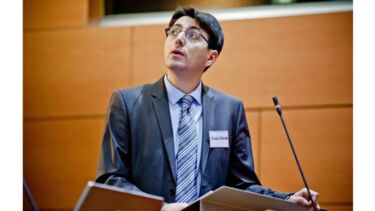ML Seminar Series - Prof. Michele Giugliano, University of Modena and Reggio Emilia

Event details
This event has taken place.
Description
Speaker: Prof. Michele Giugliano, from University of Modena and Reggio Emilia
Location: CMI Meeting Room, Room D203, Central Wing, Engineering Heartspace Building, 3 Portobello St, Sheffield, S1 4DT
Date: Friday 23 May, 15:00-16:00
Title: 'Broadband' cortical neuronal ensembles
Abstract:
Both in Neuroscience and in AI, the input-output transfer function of the units composing a large network is a pivotal element. Known as "activation function" (in Machine Learning) or as the frequency-current curve (in Neurobiology), it is a known mechanism of non-linearity as well as a biophysical primitive for neural computation. We also know that its knowledge is instrumental (in Computational Neuroscience) to analyse and predict the collective behavior of real neuronal circuits by mean-field theories. Finally, in experimental Neuroscience, the estimate of the frequency-current curve of nerve cells has been used for over three decades to classify and make sense of neuronal diversitys.
However, such a static description is inadequate to interpret how microcircuits and large networks of the brain process time-varying stimuli. Early theoretical studies and late experimental work from our group and others revealed how probing single-cell dynamical response properties is necessary to interpret of ultra-fast ensemble responses and other collective network phenomena.
In this talk, I will review the results on dynamical response properties of neurons and neuronal ensembles and put them into context of the findings of unexpected differences between rodent and human cortical neurons. Whethere these generalised biological features should be also considered for (Neuromorphic) implementation of AI systems, based on spiking neural models, is a question I will leave open to the audience.
References:
Linaro D, Ocker GK, Doiron B, Giugliano M (2019) Correlation transfer by layer 5 cortical neurons under recreated synaptic inputs in vitro, J Neuroscience, 39 (39) 7648-7663, https://doi.org/10.1523/JNEUROSCI.3169-18.2019
Linaro D, Biró I, Giugliano M (2018) Dynamical response properties of neocortical neurons to conductance-driven time-varying inputs, European Journal of Neuroscience 47(1):17–32, https://doi.org/10.1111/ejn.13761
Testa-Silva, G., Verhoog, M.B., de Kock, C.P.J., Baayen, J.C., Meredith, R.M., Giugliano, M.*, Mansvelder, H.D.* (2014) High bandwidth synaptic communication and frequency tracking in human neocortex. PLoS Biology 12(11):e1002007. http://dx.doi.org/10.1371/journal.pbio.1002007
Köndgen, H., Geisler, C., Fusi, S., X.-J. Wang, Lüscher, H.-R., Giugliano, M. (2008) The dynamical response properties of neocortical neurons to temporally modulated noisy inputs in vitro, Cerebral Cortex 18(9), 665-670. http://dx.doi.org/10.1093/cercor/bhm235http://dx.doi.org/10.1093/cercor/bhm235
Speaker Bio:
Michele Giugliano graduated in Electronic Engineering in Genoa in 1997 and completed a doctorate in Bioengineering at the Polytechnic of Milan in 2001 with Massimo Grattarola, pioneer of Neuroengineering in Italy. In 2001 he left Italy to further study neurobiology with a grant from the Human Frontiers Science Program to the medical school from the University of Bern, Switzerland. In 2005 he became a researcher at the Mind-Brain Institute of the Federal Polytechnic of Lausanne, where he worked with Henry Markram, initiator of the Human Brain Project. In 2008 he took over the chair of Neuroscience at the University of Antwerp, Belgium, where for 11 years he was Biomedical Sciences faculty, directing a research group active in Neurobiology and Neuroengineering. In 2019 he came back to Italy as a professor of Physiology at the School Superior of Advanced Studies of Trieste (SISSA), where he moved his experimental lab. Since 2024, he is Professor of Bioengineering at The University of Modena and Reggio Emilia, where is contributing to the launch of the new Master in "Bioingegneria per l'innovazione in medicina".
Location
53.381503826654, -1.4787743252679
When focused, use the arrow keys to pain, and the + and - keys to zoom in/out.
